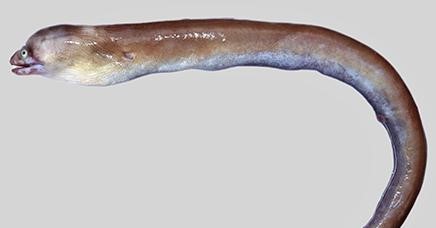Description

Disclaimer: Copyright infringement not intended.
Context: A new species of Moray eel known as Gymnothorax tamilnaduensis has been discovered at the Mudasalodai fish landing centre off the Cuddalore coast.
Details:
About:
- The species has been named after Tamil Nadu as Gymnothorax tamilnaduensis.
- The common name is Tamil Nadu brown moray.
- Family: Muraenidae.
- Their skin is thick, smooth, and scaleless, while the mouth is wide and the jaws are equipped with strong, sharp teeth, which enable them to seize and hold their prey (chiefly other fishes) but also to inflict serious wounds on their enemies, including humans.
- They are apt to attack humans only when disturbed, but then they can be quite vicious.
- Moray eels are usually vividly marked or coloured.
.jpeg)
Distribution:
- Moray eels occur in all tropical and subtropical seas, where they live in shallow water among reefs and rocks and hide in crevices.
- They differ from other eels in having small rounded gill openings and in generally lacking pectoral fins.
About Eel:
- Eel is the common name for any of the various members of the fish order Anguilliformes, which are characterized by an elongated, snake-like body, the absence of pelvic fins, and typically without scales or with the scales embedded in the skin.
- Eels generally are found in marine environments or, as in the case of the freshwater eels (family Anguillidae), catadromous, spawning in marine environments and with the young eels traveling back into freshwater.
Value for humans:
- Eels provide various values for the ecosystem and for humans.
- The unique adaptations that allow eels to be successful in their environments—primarily for wedging through small openings, while some are adapted to burrowing into soft substrates or living a pelagic existence—also adds to the wonder of nature for humans.
- Furthermore, many species, particularly freshwater varieties, are also popular as a food fish, particularly in Asia and Europe, where the meat is considered a delicacy.
- Ecologically, eels are important in food chains, acting as predators of fish and such invertebrates as crustaceans and mollusks, and being consumed in its various stages by fish, mammals, birds, and various invertebrates.
|
PRACTICE QUESTION
Q) Eels provide various values for the ecosystem and for humans. Elaborate. (150 Words)
|

https://epaper.thehindu.com/ccidist-ws/th/th_delhi/issues/30152/OPS/GBJB1N4EH.1+G3KB1NN6M.1.html












